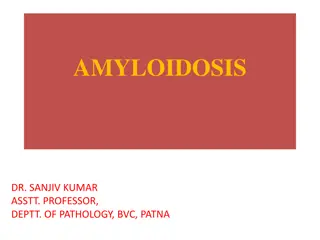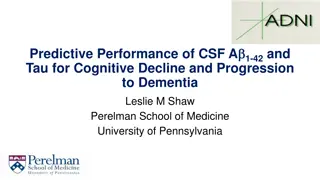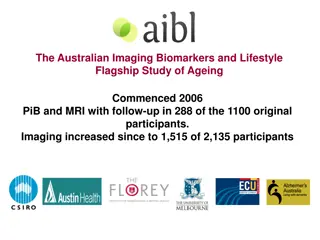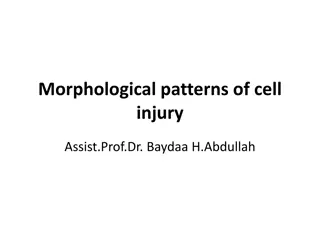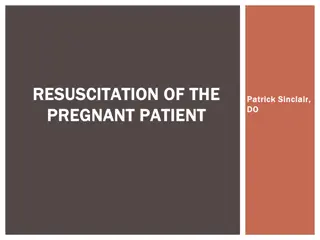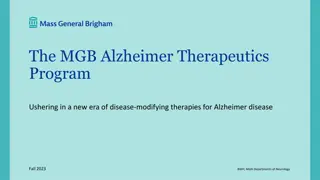Selective Aldose Reductase Inhibitor for Diabetic Cardiomyopathy Treatment
The ARISE-HF study presents primary results on the effectiveness of a selective aldose reductase inhibitor in treating diabetic cardiomyopathy, a common complication of diabetes mellitus leading to heart failure. The study highlights the increased risk of heart failure in individuals with diabetes,
2 views • 23 slides
Sudden Death and Cardiomyopathy Associated with LMNA in Nova Scotia Duck Tolling Retriever
A study on sudden death and cardiomyopathy in Nova Scotia Duck Tolling Retrievers due to LMNA association. The research includes genetic mapping, genotype verification, and functional predictions on Lamin A/C effects. Echocardiogram findings, pedigree data, genome-wide association study, whole-genom
0 views • 13 slides
Acoramidis Improves Cardiac Function in Transthyretin Amyloid Cardiomyopathy
Acoramidis, a next-generation TTR stabilizer, shows promising results in improving cardiac function and promoting regression in Transthyretin Amyloid Cardiomyopathy. The ATTRibute-CM Cardiac Magnetic Resonance Substudy evaluated changes in cardiac structure, function, and amyloid burden after treatm
0 views • 8 slides
Understanding Amyloidosis: Causes, Types, and Pathological Characteristics
Amyloidosis is a disorder characterized by the deposition of abnormal amyloid fibrils in tissues, impacting various organs. This condition is associated with different types of amyloid, such as AA and AL amyloid. The deposition of amyloid can lead to tissue damage and organ dysfunction. Primary and
1 views • 11 slides
Understanding Special Stains in Pathology
Special stains in pathology provide crucial diagnostic information beyond routine stains like H&E. They help highlight specific tissue components like carbohydrates, amyloid, nucleic acids, lipids, microorganisms, connective tissues, pigments, and minerals. This article delves into the classificatio
0 views • 19 slides
Australian Imaging Biomarkers and Lifestyle Study: Progress and Focus
The Australian Imaging Biomarkers and Lifestyle Study of Ageing (AIBL) commenced in late 2006, with a cohort size and follow-up progress detailed. The study includes assessments and biomarker imaging, such as MRI, amyloid PET, and tau PET scans, with ongoing review cycles and data additions. Current
0 views • 12 slides
Predictive Performance of CSF A1-42 and Tau on Cognitive Decline and Dementia Progression
Analysis conducted at the Perelman School of Medicine, University of Pennsylvania, evaluated the predictive performance of cerebrospinal fluid markers A1-42, t-tau, and p-tau181 on cognitive decline and progression to dementia. The study included 2401 ADNI1/GO/2 CSF samples from individuals across d
0 views • 19 slides
Understanding Cell Injury and Degeneration in Response to Various Stressors
Cell injury can result from multiple stressors such as hypoxia, physical agents, chemicals, microbes, immunologic factors, nutritional imbalances, and aging. This can lead to reversible changes (degeneration) or irreversible changes (necrosis). Types of degeneration include cloudy swelling, hydropic
0 views • 22 slides
Understanding Hypertrophic Cardiomyopathy (HCM) in a Middle-Aged Female with Heart Failure
A 55-year-old female with a history of hypertension and heart failure presented with symptoms of dyspnea, chest pain, and a positive family history of cardiac disease. Exam findings included LVH on ECG and a systolic murmur at LLSB. This case highlights the importance of recognizing and managing hyp
0 views • 20 slides
Australian Imaging Biomarkers and Lifestyle Study Overview
The Australian Imaging Biomarkers and Lifestyle Flagship Study of Ageing began in 2006 with PiB and MRI assessments. Over time, the study has expanded to include more participants and various imaging modalities. Current focuses include converting amyloid results to centiloid units, exploring blood b
1 views • 7 slides
The Urgent Need for Developing New Antibiotics
Antibiotic resistance has led to devastating consequences, with lives lost and individuals suffering from resistant infections. This urgency is highlighted through real-life cases of individuals facing complications due to antibiotic-resistant bacteria. The narrative follows a 46-year-old man with e
0 views • 19 slides
Morphological Patterns of Cell Injury and Degeneration
This informative content discusses morphological patterns of cell injury, focusing on reversible cell injury or degeneration caused by intracellular and interstitial accumulations. It covers classifications such as primary changes in the cell, intracellular accumulation of water, fat, carbohydrates,
0 views • 18 slides
Understanding Chronic Heart Failure: Causes, Symptoms, and Treatment
Chronic heart failure is a serious condition caused by various factors such as coronary artery disease, hypertension, and cardiomyopathy. It involves both left-sided and right-sided symptoms, impacting quality of life and survival. Treatment aims to manage symptoms, slow disease progression, and imp
0 views • 37 slides
Managing Pregnancy-Related Complications: A Comprehensive Overview
Understand the risks and causes of pregnancy-related complications such as resuscitation, DIC, peripartum cardiomyopathy, and more. Learn about management strategies including resuscitation protocols, DIC treatment, and heart failure management. Dive into the prevalence, causes, and treatment of the
0 views • 14 slides
Advancements in Alzheimer Disease Therapeutics Program
The MGB Alzheimer Therapeutics Program is a collaborative effort leading to groundbreaking disease-modifying therapies for Alzheimer's disease. The development of Lecanemab (Leqembi), a monoclonal antibody targeting amyloid plaques, offers a new option to slow disease progression. The program's focu
0 views • 21 slides
Understanding Myocarditis: Causes, Pathology, and Epidemiology
Inflammation of the heart muscle, known as myocarditis, can be caused by various agents including viruses, parasites, and autoimmune conditions. The pathology involves cardiac injury triggering an immune response, leading to acute destruction and potentially progressing to cardiomyopathy. Viral caus
0 views • 70 slides



